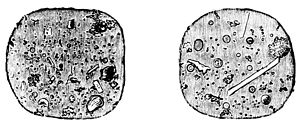without water, and the yolk of egg, grew putrid as rapidly as in common air.
The result of these experiments is, that there are spontaneous decompositions of organic substances which require nothing but the presence of oxygen gas to cause them to commence; while others need, besides oxygen, the presence in the atmospheric air of those unknown things, which are destroyed by heat or sulphuric acid, or are retained by the cotton.
The two observers do not then decide on the nature of these things, and do not assert categorically that they are germs, and, in reality, nothing allows us to draw these conclusions.
M. Pasteur's experiments have advanced the question another step, by proving that they are really germs of ferments and infusoria, which are destroyed by heat, or arrested by the sulphuric acid or cotton in the experiments alluded to above.
M. Pasteur made a hole in a window-shutter, several metres above the ground, and through this he passed a glass tube .196 inch in diameter, and containing a plug of soluble cotton .39 inch in length, kept in its place by a spiral platinum wire. One of the ends of this tube passed into the street; the other communicated with a continuous aspirator. When the air had passed for a sufficient time, the plug of cotton, more or less soiled by the dust which it had intercepted, was placed in a small tube with the mixture of alcohol and ether, which dissolves gun-cotton. It was left for the space of a day. All the dust was deposited at the bottom of the tube, where it is easy to wash it by decantation, without any loss, if care is taken to separate each washing by an interval of repose of from twelve to twenty hours. The deposit, and the liquid which covers it, are put in a watch-glass together; after the evaporation of the alcohol, the remainder is placed in water, and examined with the microscope. M. Pasteur also made use of ordinary sulphuric acid in order to moisten the dust. This agent had the effect of separating the grains of starch and calcium carbonate, which are always found in greater or less quantities in deposits collected on the plug of cotton.

Figs. 1 and 2.—Organic Corpuscles of Dust, mixed with Amorphous Particles.
Figs. 1 and 2 represent organic corpuscles, associated with amorphous particles, as seen through the microscope, under a power of 350 diameters; the liquid containing them was common sulphuric acid.

